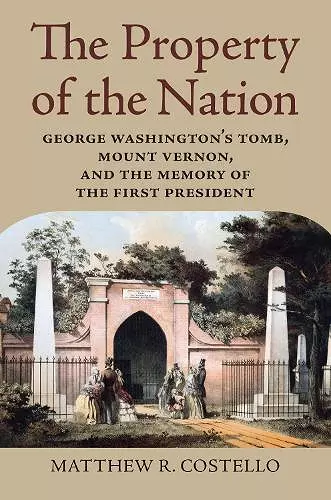The Property of the Nation
George Washington's Tomb, Mount Vernon, and the Memory of the First President
Format:Hardback
Publisher:University Press of Kansas
Published:30th Oct '19
Currently unavailable, our supplier has not provided us a restock date

George Washington was an affluent slave owner who believed that republicanism and social hierarchy were vital to the young country’s survival. And yet, he remains largely free of the “elitist” label affixed to his contemporaries, as Washington evolved in public memory during the nineteenth century into a man of the common people, the father of democracy. This memory, we learn in The Property of the Nation, was a deliberately constructed image, shaped and reshaped over time, generally in service of one cause or another. Matthew R. Costello traces this process through the story of Washington’s tomb, whose history and popularity reflect the building of a memory of America’s first president—of, by, and for the American people.
Washington’s resting place at his beloved Mount Vernon estate was at times as contested as his iconic image; and in Costello’s telling, the many attempts to move the first president’s bodily remains offer greater insight to the issue of memory and hero worship in early America. While describing the efforts of politicians, business owners, artists, and storytellers to define, influence, and profit from the memory of Washington at Mount Vernon, this book’s main focus is the memory-making process that took place among American citizens. As public access to the tomb increased over time, more and more ordinary Americans were drawn to Mount Vernon, and their participation in this nationalistic ritual helped further democratize Washington in the popular imagination. Shifting our attention from official days of commemoration and publicly orchestrated events to spontaneous visits by citizens, Costello’s book clearly demonstrates in compelling detail how the memory of George Washington slowly but surely became The Property of the Nation.
In the first half of the nineteenth century, political parties and organizations, entrepreneurs and tourists, authors and artists, and descendants and enslaved people helped democratize George Washington’s image while staking their own claims to the nation’s history. Through meticulous research and graceful prose, Matthew Costello illuminates insightfully how Washington’s body, tomb, relics, and stories became vehicles for recasting the father of his country as a man who belonged not just to a Virginian elite but to all Americans." - Scott E. Casper, author of Sarah Johnson’s Mount Vernon: The Forgotten History of an American Shrine, dean of the College of Arts, Humanities, and Social Sciences, and professor of history, University of Maryland
"The Property of the Nation roots today’s larger-than-life image of George Washington in the complicated, intertwined processes of icon- and nation-making. Over the first half of the nineteenth century, politicians, enslaved African Americans, women, and the rising middling class played tug-of-war with Washington’s symbolic meaning. Each laid claim to his vision for the new nation, revealing different motivations and visions for America’s young democracy." - Lydia Mattice Brandt, author of First in the Homes of His Countrymen: George Washington’s Mount Vernon in the American Imagination
"For well over a century, the focus of the roughly one million people who come to Mount Vernon each year has been the ancestral Virginia mansion that served as George Washington’s residence. This was not, however, the case for much of the first decades after his death, before historic preservation became a thing, when what resonated with the people who made the journey to Mount Vernon was not Washington’s home but his burial place. Not grand or imposing, the original family tomb was a small brick structure nestled in a forested clearing, just down the hill from the imposing mansion. In this new book, Matthew Costello tells the long-untold story of that tomb and how Washington, a lifelong member of the Virginia aristocracy, came to be embraced as a symbol of American democracy and a man of the American people." - Mary V. Thompson, research historian, Fred W. Smith National Library for the Study of George Washington
ISBN: 9780700628278
Dimensions: 233mm x 157mm x 33mm
Weight: 678g
352 pages